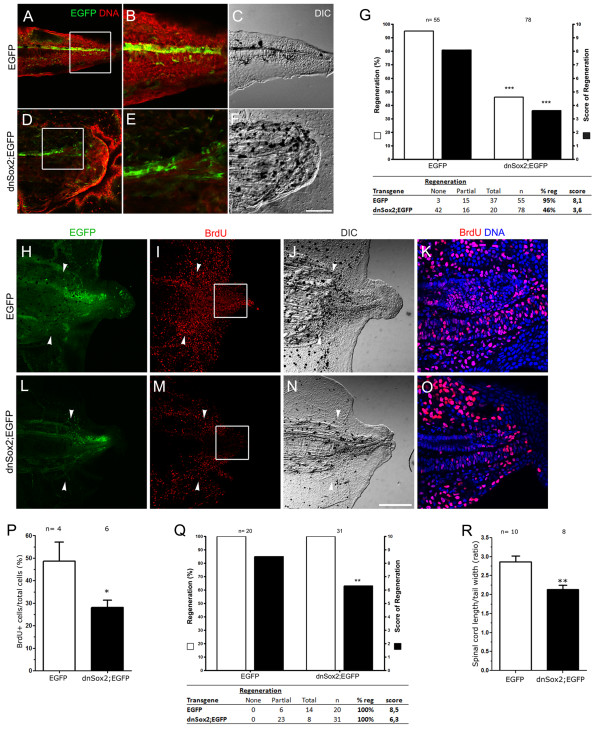Figure 4.
Overexpression of a dominant negative form of Sox2 impairs tail regeneration. (A-F) Sagittal optical sections showing the predominant phenotype of regenerated tails in (A-C) enhanced green fluorescent protein (EGFP; total regeneration) and (D-F), dnSox2; EGFP (no regeneration) F0 transgenic tadpoles amputated at stage 42. (A,B,D,E) Images showing transgenic EGFP expression (green) and DNA (red) staining. (B,E) Higher magnifications from the areas indicated in (A) and (D), respectively. (C,F) Differential interference contrast (DIC) microscopy from (A) and (D), respectively. (G) Graph showing the regenerative efficiency of EGFP and dnSox2; EGFP stage 42 transgenic tadpoles. White bars represent the percentage of regeneration and black bars the score of regeneration. dnSox2; EGFP tadpoles have a decrease of regenerative efficiency compared to EGFP. (H-O) 5-Bromo-2'-deoxyuridine (BrdU) incorporation in (H-K) EGFP and (L-O) dnSox2;EGFP F0 transgenic stage 49 tadpoles at 4 days post amputation (dpa) and (J,N) DIC microscopy from tails depicted in (H) and (L). (K-O) Magnification of the zone labeled in (I) and (M). (P) Graph showing the percentage of BrdU+ cells in the spinal cord from high EGFP expressing transgenic tadpoles represented in (K) and (O). BrdU incorporation was diminished in dnSox2; EGFP compared to EGFP controls. (Q) Regenerative efficiency of EGFP and dnSox2; EGFP transgenic tadpoles amputated at stage 48, a decrease in the score of regeneration was observed in dnSox2; EGFP. (R) Graph showing that the regenerated spinal cord length of dnSox2; EGFP transgenic tadpoles decreased compared to controls (EGFP). The length of the spinal cord was corrected by the tail width. (G,P-R) The number of tadpoles analyzed (n) is indicated above the bars. Scale bars: 50 μm.

